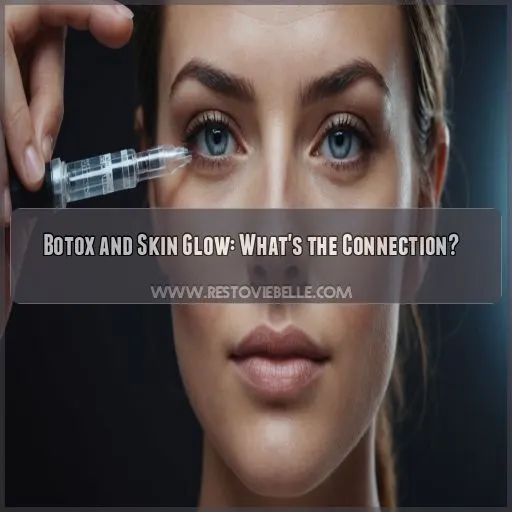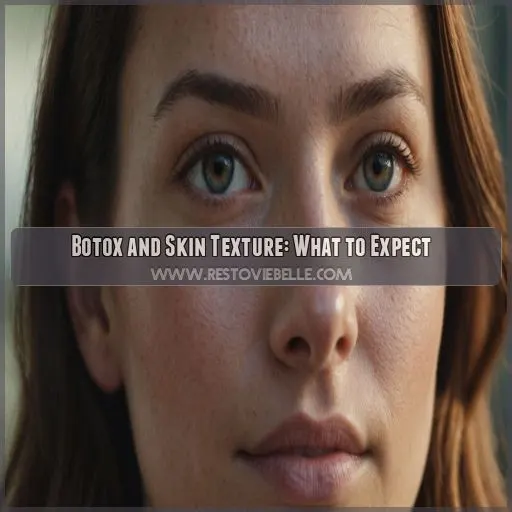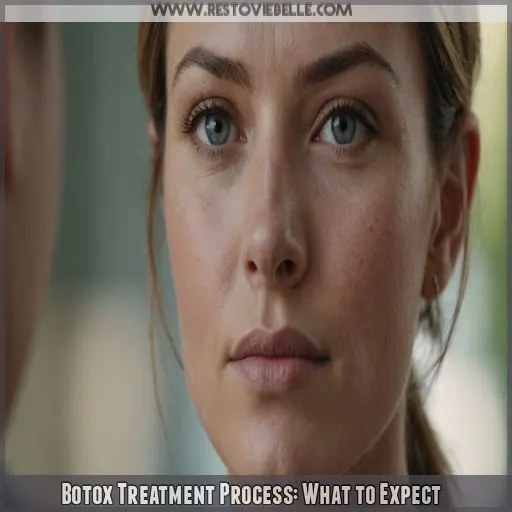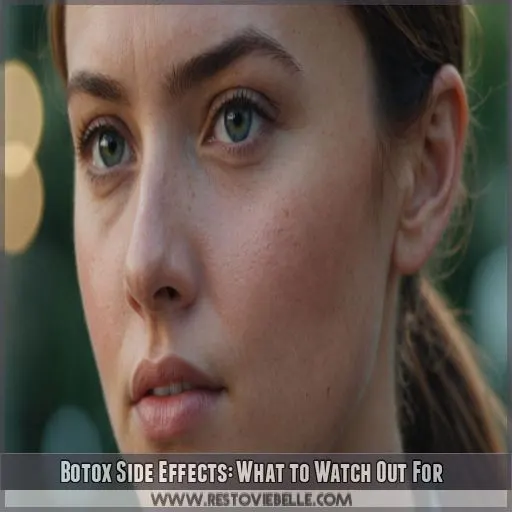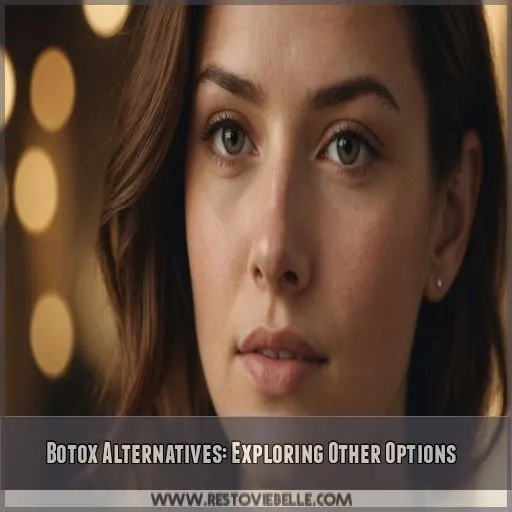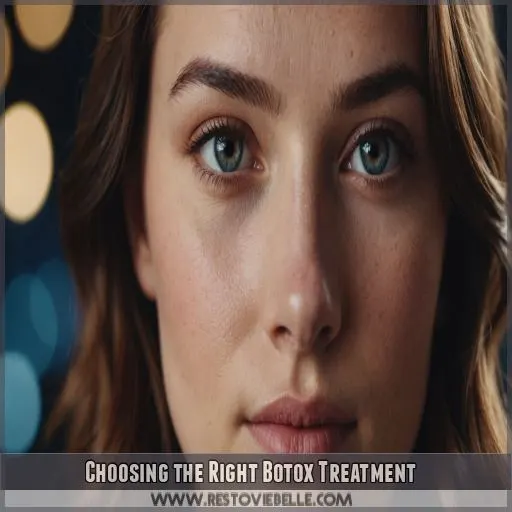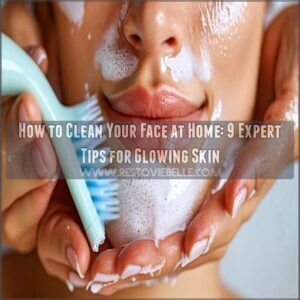This site is supported by our readers. We may earn a commission, at no cost to you, if you purchase through links.
 You’re wondering if Botox will make your skin shiny? Well, you’re not alone! It’s a common concern, especially if you’re new to neurotoxins.
You’re wondering if Botox will make your skin shiny? Well, you’re not alone! It’s a common concern, especially if you’re new to neurotoxins.
The answer is: it’s possible, but not a guarantee. When Botox relaxes your facial muscles, it can make your skin look smoother and more radiant, which can sometimes translate to a shiny appearance.
However, this is usually due to over-injection or incorrect technique. A qualified practitioner will know just the right amount to use, so don’t worry, you won’t be left looking like a disco ball!
But, there’s more to the story…
Table Of Contents
- Key Takeaways
- Does Botox Make Your Skin Shiny?
- Botox and Skin Glow: What’s the Connection?
- Botox and Skin Texture: What to Expect
- Botox Treatment Process: What to Expect
- Botox Results: How Long Do They Last?
- Botox Side Effects: What to Watch Out For
- Botox Alternatives: Exploring Other Options
- Choosing the Right Botox Treatment
- Frequently Asked Questions (FAQs)
- Why does your skin look shiny after Botox?
- Does Botox make your skin glowy?
- Does Botox change the texture of your skin?
- What does Botox do to your skin over time?
- Can Botox be used to treat facial asymmetry issues?
- How does Botox affect facial expressions and emotions?
- Can Botox be combined with other cosmetic treatments safely?
- What are the differences between Botox and Dysport treatments?
- Can Botox be used to treat excessive sweating problems?
- Conclusion
Key Takeaways
- You might notice that your skin looks shiny after Botox, but don’t worry, it’s not the Botox itself – it’s usually due to temporary inflammation, increased blood flow, or a bit too much of the good stuff (over-injection or incorrect technique).
- Botox can give your skin a radiant glow by reducing muscle movement, which helps minimize water loss and improve hydration – just think of it as a refreshing drink of water for your skin!
- Repeated Botox Treatments can actually improve your skin’s elasticity and collagen production over time, giving you a smoother, more radiant complexion – it’s like a little mini-vacation for your skin.
- To minimize the risk of a shiny face, choose a qualified practitioner who knows their stuff, follow pre- and post-treatment care instructions, and don’t be afraid to ask questions – after all, it’s your face, and you want to look your best!
Does Botox Make Your Skin Shiny?
You’re considering Botox, but you’re wondering: will it make your skin look shiny? The answer lies in how Botox affects your skin’s texture and appearance, and it’s not as straightforward as you might think.
How Botox Affects Skin Texture and Appearance
You’re curious about Botox and its effects on skin texture and appearance. Let’s get started! When Botox relaxes facial muscles, it can also make your skin look smoother and more even.
- Botox reduces wrinkle formation by decreasing muscle contractions
- Relaxed muscles lead to smoother skin surfaces and reduced fine lines
- Improved skin elasticity gives your skin a more radiant and youthful appearance
Why Your Skin May Look Shiny After Botox
| Causes of Shininess | What’s Happening |
|---|---|
| Skin Hydration | Botox increases moisture levels, giving skin a radiant glow. |
| Post-Injection Swelling | Temporary swelling can cause skin to appear shiny. |
| Product Application | Certain products can leave a residue, making skin look shiny. |
How Long the Shiny Effect Lasts
The shiny effect of Botox can last anywhere from a few days to several weeks . Here’s what influences it:
- Your skin’s natural oil production
- Hydration levels (Source)
- The skill of your practitioner
- Your individual skin type
Botox and Skin Glow: What’s the Connection?
You might be wondering if Botox can actually give your skin a radiant glow – and the answer might surprise you! As it turns out, Botox can indeed have a positive effect on your skin tone and radiance, and it’s not just about freezing wrinkles – it’s also about revealing a brighter, more even-toned you.
How Botox Improves Skin Tone and Radiance
You’re probably wondering how Botox improves skin tone and radiance. By temporarily relaxing facial muscles, Botox reduces wrinkles and fine lines, giving your skin a smoother appearance. This, combined with proper skin hydration and rejuvenation, can boost skin elasticity and radiance. The result? A more youthful, radiant you!
How Botox Enhances Skin Clarity and Brightness
You’re probably wondering how Botox can boost your skin’s clarity and brightness. Well, here’s the scoop! By relaxing facial muscles, Botox reduces the appearance of forehead lines and frown lines, giving your skin a smoother, more radiant look.
Here are 4 ways Botox enhances skin clarity and brightness:
- Relaxes facial muscles: Reduces wrinkle formation, giving skin a smoother appearance.
- Reduces pore size: Minimizes the appearance of large pores, making skin look more refined.
- Fades age spots: Helps reduce hyperpigmentation, evening out skin tone.
- Improves skin texture: Leaves skin looking brighter, more even-toned, and refreshed.
Botox and Skin Texture: What to Expect
You’re probably wondering what Botox does to your skin texture beyond just relaxing wrinkles – will it leave you looking shiny or radiant? Let’s explore how Botox changes your skin texture over time and whether it can even help with skin conditions like acne and hyperpigmentation.
How Botox Changes Skin Texture Over Time
You’re probably wondering, "How does Botox change my skin texture over time?" Well, let’s break it down. With repeated Botox treatments, your skin’s elasticity and collagen production may improve, giving you a smoother, more radiant complexion. Here’s a snapshot of what you can expect:
| Timeframe | Skin Texture Changes |
|---|---|
| 1-3 months | Improved skin elasticity, reduced fine lines |
| 4-6 months | Enhanced collagen production, smaller pore size |
| 7+ months | Long-term effects, potential for reduced facial expressions |
Keep in mind, individual results may vary, and side effects like enlarged pores are rare.
How Botox Treats Skin Conditions Like Acne and Hyperpigmentation
You’re probably wondering if Botox can help with acne scars and hyperpigmentation. Well, the answer is yes! Botox can improve skin texture by reducing inflammation and preventing breakouts. Combined with LED light therapy, Botox can even out skin tone and reduce hyperpigmentation. It’s a game-changer for smoother, brighter skin!
Botox Treatment Process: What to Expect
As you consider getting Botox, it’s important to know what to expect from the treatment process to make sure you have a smooth and successful experience. From pre-treatment preparation to post-treatment care, understanding the steps involved will help you feel more comfortable and informed throughout your Botox journey (Source).
Pre-Treatment Preparation and Guidelines
Before your Botox treatment, prep your skin with a consistent skincare routine and avoid certain medications. Stay hydrated and choose a qualified practitioner, like a medical professional in New York City, to minimize risks and guarantee a smooth experience.
The Botox Injection Process: Step-by-Step
You’re about to get Botox – exciting! During the 30-minute process, a practitioner will clean and numb the area, then inject Botox into specific muscles. You might feel a slight pinch, but it’s quick and relatively painless.
Post-Treatment Care and Recovery Instructions
After Botox, take it easy! Reduce swelling with a cold compress, avoid strenuous exercise, and skip makeup for 24 hours. Use sunscreen daily and consider arnica gel for bruising. Follow these simple tips for a smooth, speedy recovery.
Botox Results: How Long Do They Last?
You’re probably wondering how long that smooth, wrinkle-free skin will last after your Botox treatment. The good news is that Botox results typically last for 3-4 months, but the exact duration depends on several factors, including your lifestyle, age, and individual metabolism.
The Average Duration of Botox Results
Now that you know what to expect during the Botox treatment process, let’s talk results! On average, Botox results last around 3-4 months , but this can vary from person to person, and maintenance treatments are necessary.
Factors Affecting the Longevity of Botox Results
Your Botox results can be influenced by your lifestyle, individual metabolism, and muscle strength. Treatment frequency and age factors also play a role. These factors can affect how long your Botox results last, making each person’s experience unique.
How to Maintain Botox Results With Follow-Up Treatments
To maintain Botox results, schedule follow-up treatments every 3-4 months. Sticking to this timeline helps maintain facial balance and prevents wrinkles from reappearing. Your practitioner will help customize a plan, optimizing dosage and treatment intervals for your best look.
Botox Side Effects: What to Watch Out For
As you evaluate Botox treatments, being aware of the potential side effects is vital, so you can make informed decisions about your care. While generally safe, Botox can cause some common side effects, and in rare cases, more serious issues can arise – but don’t worry, we’ll provide you with the inside scoop on what to watch out for!
Common Side Effects of Botox Injections
As you consider Botox, you should be aware of the common side effects, including temporary pain, facial asymmetry, and droopy eyelids. These typically resolve on their own, but discussing pain management with your practitioner can help minimize discomfort.
Rare but Serious Side Effects of Botox
Though rare, serious Botox side effects can occur, including allergic reactions, poisoning symptoms, facial asymmetry, drooping eyelids, and spread risks. If you experience any unusual symptoms, seek medical attention right away to safeguard your safety.
How to Minimize the Risk of Botox Side Effects
To minimize Botox side effects, focus on pre-treatment care, dosage control, and healthy patient selection. Follow post-injection protocols, and set realistic expectations with your practitioner. By being proactive, you can reduce risks and enjoy a smoother, worry-free experience.
Botox Alternatives: Exploring Other Options
You’re considering Botox, but you’re also curious about other options – and rightfully so! Let’s explore the non-invasive, surgical, and natural alternatives to Botox that can help you achieve the smooth, radiant skin you’re after.
Non-Invasive Alternatives to Botox
Considering Botox alternatives? You’ve got options! Facial massage, chemical peels, microdermabrasion, laser resurfacing, and retinoid treatments can help smooth fine lines and wrinkles without the needle. Let’s explore these non-invasive Botox alternatives and find what works best for you.
Surgical Alternatives to Botox
If you’re looking for a more permanent solution, consider surgical alternatives like facelift surgery, brow lift, eyelid surgery, or facial implants. Chemical peels can also help, but they might require more downtime and have varying results.
Natural Alternatives to Botox: Do They Work?
Considering natural alternatives to Botox? You’re not alone. Many are turning to plant-based options to reduce wrinkles. Here are some herbal helpers:
- Aloe vera for skin hydration
- Green tea for antioxidant power
- Chamomile for calming effects
- Rosehip oil for collagen boost
- Facial massage for increased blood flow
Choosing the Right Botox Treatment
As you consider Botox to smooth out those pesky fine lines and wrinkles, finding the right practitioner is vital to achieving a shiny, healthy-looking complexion – not just a shiny face. By choosing a qualified expert and being prepared for your consultation, you’ll be on your way to radiant, youthful-looking skin that turns heads for all the right reasons.
Finding a Qualified Botox Practitioner
When finding a qualified Botox practitioner, look for credentials like board certification and extensive experience. Check online reviews and ask friends for referrals. Consider the following qualifications to confirm you’re in good hands:
| Qualification | What to Look For |
|---|---|
| Board Certification | A medical license and certification from a reputable board like the American Board of Dermatology |
| Experience | A proven track record of successful Botox treatments and satisfied clients |
| Reviews | Positive online reviews and ratings from multiple sources like Google and Yelp |
How to Prepare for Your Botox Consultation
Now that you’ve found a qualified Botox practitioner, it’s time to prep for your consultation. Here are 4 things to keep in mind:
- Gather medical history: Share previous treatments and health conditions.
- Understand facial mapping: Know how Botox will be used on your face.
- Set realistic expectations: Botox isn’t a miracle worker, but it can help.
- Discuss costs: Know what you’re paying for and why.
What to Ask Your Botox Practitioner Before Treatment
Before treatment, ask your Botox practitioner about dosage concerns, facial asymmetry correction, cost factors, and treatment area options. Don’t forget to discuss aftercare needs, like avoiding strenuous activities and managing potential bruising or swelling.
Frequently Asked Questions (FAQs)
Why does your skin look shiny after Botox?
You’ve just gotten Botox and can’t help but notice your skin looks shiny – what’s going on? Don’t worry, it’s not the Botox itself, but rather the temporary inflammation and increased blood flow to the treated areas!
Does Botox make your skin glowy?
Botox can give your skin a glowy appearance by reducing muscle movement, which helps minimize water loss and improve hydration (Source). This results in a more radiant and vibrant complexion, especially when combined with a good skincare routine.
Does Botox change the texture of your skin?
You might notice a smoother skin texture after Botox treatments , but it won’t drastically change your skin’s natural texture. Botox relaxes facial muscles, reducing wrinkles and fine lines, giving your skin a more even appearance .
What does Botox do to your skin over time?
Over time, Botox can help improve your skin’s texture and appearance by relaxing facial muscles, reducing wrinkles, and preventing new ones from forming, giving you a smoother, more youthful look .
Can Botox be used to treat facial asymmetry issues?
Think of Botox as a master puppeteer, subtly tweaking the strings of your facial muscles. By relaxing specific areas, it can help balance out facial asymmetry issues, creating a more harmonious and refreshed look.
How does Botox affect facial expressions and emotions?
When you get Botox, it temporarily relaxes your facial muscles, reducing wrinkles and fine lines. This can also affect your emotional expressions and experiences, as your brain receives fewer signals from your relaxed facial muscles .
Can Botox be combined with other cosmetic treatments safely?
You can safely combine Botox with other cosmetic treatments like dermal fillers, chemical peels, and microneedling . Laser treatments can also be paired with Botox, but it’s best to do them first and wait a week before getting Botox injections .
What are the differences between Botox and Dysport treatments?
You’re considering Botox or Dysport for wrinkle treatment, but what’s the difference? Both contain botulinum toxin, but Dysport has smaller molecules, allowing it to spread further and work faster, with results lasting around 4 months .
Can Botox be used to treat excessive sweating problems?
You’re in luck! Botox can indeed help treat excessive sweating problems . The FDA has approved Botox injections to temporarily block nerve signals that stimulate sweat glands, reducing underarm sweating .
Conclusion
Don’t let the fear of a shiny face stop you from trying Botox. While it’s true that Botox can sometimes make your skin look smoother and more radiant, this is usually due to over-injection or incorrect technique.
A qualified practitioner will know just the right amount to use, ensuring that you achieve the desired results without looking unnatural.

